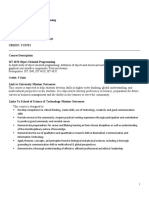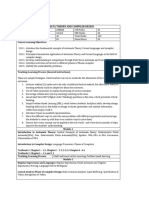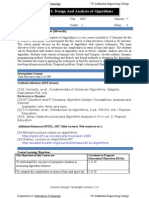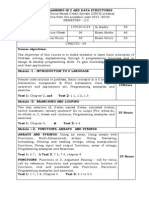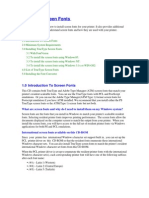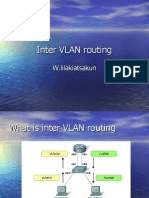Birla Institute of Technology and Science First Semester, 2012-2013 Instruction Division Course Handout (Part 2)
Birla Institute of Technology and Science First Semester, 2012-2013 Instruction Division Course Handout (Part 2)
Uploaded by
Hiramani SinghCopyright:
Available Formats
Birla Institute of Technology and Science First Semester, 2012-2013 Instruction Division Course Handout (Part 2)
Birla Institute of Technology and Science First Semester, 2012-2013 Instruction Division Course Handout (Part 2)
Uploaded by
Hiramani SinghOriginal Description:
Original Title
Copyright
Available Formats
Share this document
Did you find this document useful?
Is this content inappropriate?
Copyright:
Available Formats
Birla Institute of Technology and Science First Semester, 2012-2013 Instruction Division Course Handout (Part 2)
Birla Institute of Technology and Science First Semester, 2012-2013 Instruction Division Course Handout (Part 2)
Uploaded by
Hiramani SinghCopyright:
Available Formats
BIRLA INSTITUTE OF TECHNOLOGY AND SCIENCE First Semester, 2012-2013 Instruction Division Course Handout (Part 2)
In addition to the Part-1 (general Handout for all courses appended to the timetable) this portion gives further specific information regarding the course. Course Number Course Title Instructor In Charge Instructor : : : : CS F213/IS F213 Object Oriented Programming YASHVARDHAN SHARMA Sunita Bansal, Avinash Gautam
Scope and Objective: This course provides the students good understanding in object-oriented design, design patterns and java language including graphical user interface programming. After learning this course, students will have good understanding of OO design, design patterns and Java programming. Given a problem, students will be able to select and apply a suitable design pattern. Text Book: T1: Object Oriented Design & Patterns, Cay Horstmann, John Wiley & Sons, 2004 References: 1. The complete Reference Java 2, 5th Edition, Herbert Schildt, Tata McGraw Hill publishing 2. JavaTM Design Patterns A Tutorial, James W. Cooper, Addison-Wesley, 2000 Lecture Schedule: Lecture No. Learning Objectives 1, 2 To learn the basic syntax of Java and OOP principles.
3 4
Topics to be covered Writing Hello, World program in java, primitive types and control flow statements, the minor differences between C and Java syntax To learn classes and Classes, Objects, Constructors and objects Methods To learn the object variables of class type and null references, passing type, method overloading, parameters as objects, and method overloading To learn static fields and Static fields and static methods static methods User Input Classes, Accessors and Mutators, Final instance fields, To learn the concept of Packages, importing packages, modularity packages in java library
Chapters T1: Chapter 1, Sec. 1.1 to 1.4, class notes class notes T1:Chapter 1, Sec. 1.5 to 1.6, class notes T1:Chapter 1, Sec 1.10 ,Sec 1.13 T1:Chapter 1, Sec 1.7 and class notes 1
7,8
Learning Arrays and Strings Learning Dynamic Arrays To learn the concept of Encapsulation To learn Inheritance
10
11, 12 13, 14, 15 To learn interfaces and Polymorphism To learn how to handle exceptions To learn the Java Object Model To learn multi thread programming To learn the concept of Delegation Event Model To learn Swings and User interface programs Learning Patterns and GUI programming
16, 17, 18
19, 20
21, 22, 23
Arrays and Multi-dimensional arrays, Strings, StringBuffer, StringTokenizer ArrayList and Vector classes and the use of Iterators, Linked List and List Iterators Access Specifiers to methods and fields Inheritance, abstract classes, Instance variable hiding, Method overriding interfaces, Comparator and Comparable interfaces, Inner classes ,Anonymous classes Exception classes in Java library, try catch blocks, the key words throw, throws and finally The Java Type System, Type Inquiry, The Object class, Shallow and Deep Copy Thread Basics, Thread synchronization Event Handling, Delegation Event Model User interface components, User interface actions, The Icon interface type Pattern Concept, The Observer pattern, Components and Containers and the Composite Pattern, Layout Managers and the Strategy Pattern, Scroll Bars and the Decorator Patterns file handling ,JDBC Concepts and database applications Identifying classes, methods and relationships between classes Use cases, CRC cards
T1:Chapter 1, Sec:1.9, 1.12 Chapter 1, Sec 1.11 and Class notes
T1: Chapter 6, Sec 6.1 and class notes T1: Chapter 4, Sec 4.2, 4.4, 4.5, 4.6 T1:Chapter 1, Sec 1.8 and class notes T1: chapter 7 Sec 7.1 7.4 T1:Chapter 9, Sec 9.1 and 9.2 class notes T1: chapter 4 Sec 4.1, 4.7, 4.8 T1: chapter 5 Sec. 5.2 5.6
24 25, 26
27, 28
29,30
31 32
33
To learn how to handle the files, Database Connectivity To learn the Object Oriented Design Process To learn the Object Oriented Design Process To learn the Object Oriented Design Process To learn the Object Oriented Design Process To learn how to analyze the quality of an
Class Notes
T1: Chapter 2, Sec 2.2 - 2.5 T1: Chapter 2, Sec 2.6 & 2.7. T1:Chapter 2, Sec. 2.8 T1: Chapter 2, Sec 2.9 & 2.10 T1: Chapter 3 Sec. 3.5 2
UML class diagram
34
Sequence diagrams and State diagrams Separation of Accessors and Mutators, Side effects
35
interface
36 37-40
To learn how to write program by contract To learn more Design Patterns
Cohesion, Completeness, Convenience, Clarity and Consistency Preconditions, Assertions, Post conditions, Class Invariants The Adapter Pattern, Actions and the Command Pattern, The Factory Method Pattern , The Proxy Pattern, The Singleton Pattern, The Visitor Pattern
T1:Chapter 3, Sec. 3.6 T1:Chapter 10 Sec. 10.1, 10.2, 10.3, 10.4, 10.5, 10.6
Evaluation Scheme: Component Midsem Test Tutorials Online Test Comprehensive Duration 50 minutes 30 minutes 90 minutes 3 hours Date, Time and Venue Marks 50 30 40 80 Nature Closed Book Closed Book open book Partly open book
Chamber Consultation: To be announced in the class
Mid Semester Grading :
The mid-semester grading will be announced on the basis of the midsem test and one tutotial. Make Up Policy : Make up for midsem test would be given to students who are unable to take the test due to ill health or any other unavoidable reasons. The application for make up must reach the instructor-in-charge before the test date. No makeup will be granted WITHOUT THE PRIOR PERMISSION of the instructor-in-charge. There will be no make up for the online test and tutorials. Notices: All notices related to the course will be put up on the IPC Notice Board only. Instructor-In-Charge BITS C342
You might also like
- Second Semester 2018-19: Course Handout (Part Ii)Document4 pagesSecond Semester 2018-19: Course Handout (Part Ii)Jayakanth TeegalaNo ratings yet
- Course Description Document Advanced Java CSF206 AY 2022 23Document8 pagesCourse Description Document Advanced Java CSF206 AY 2022 23Siddharth RawatNo ratings yet
- IST 4070 Course SyllabusDocument7 pagesIST 4070 Course SyllabusJames MonchoiNo ratings yet
- CSE 215 Course Objective and OutcomeDocument3 pagesCSE 215 Course Objective and OutcomeMahbub KousarNo ratings yet
- DBMS SyllabusDocument4 pagesDBMS SyllabusRishabh PatelNo ratings yet
- ECE 3141 IIUM Data Communications (Updated and Mapped) Sem-1 2016-17 Course OutlineDocument6 pagesECE 3141 IIUM Data Communications (Updated and Mapped) Sem-1 2016-17 Course Outlinetihah94No ratings yet
- Course Outline Eee343 Fall16 FtoDocument5 pagesCourse Outline Eee343 Fall16 FtoToaha HasnainNo ratings yet
- CSD410 Introduction To Computer ApplicationsDocument7 pagesCSD410 Introduction To Computer Applicationsak4952961No ratings yet
- JavaDocument521 pagesJavaMunavalli Matt K S100% (1)
- COME207 Instruction Manual Fall 2009-2010Document4 pagesCOME207 Instruction Manual Fall 2009-2010Serhat JungNo ratings yet
- Issyll MergedDocument15 pagesIssyll MergedLavanya YM. 46No ratings yet
- Computer Fundamental Course SpecificationDocument3 pagesComputer Fundamental Course SpecificationalphapeelerNo ratings yet
- Operations Research IDocument2 pagesOperations Research IKhaled TitiNo ratings yet
- Pvp14 Regulations Computer Science & Engineering PvpsitDocument2 pagesPvp14 Regulations Computer Science & Engineering PvpsitAfsaribegum MohammadNo ratings yet
- V Sem CourseInfo 2012 With QuestionsDocument37 pagesV Sem CourseInfo 2012 With QuestionsvasunewsNo ratings yet
- Programming in C and Data StricturesDocument3 pagesProgramming in C and Data StricturesAnuNo ratings yet
- Issyll21 75 76Document2 pagesIssyll21 75 76ise.shailajabNo ratings yet
- BE Syllabus PDFDocument2 pagesBE Syllabus PDFpradeepNo ratings yet
- Holy Cross of Bansalan College Bansalan, Davao Del Sur A.Y 2011-2012 Syllabus in IT 124 (Program Logic Formulation) Curriculum Pacing GuideDocument8 pagesHoly Cross of Bansalan College Bansalan, Davao Del Sur A.Y 2011-2012 Syllabus in IT 124 (Program Logic Formulation) Curriculum Pacing GuideLindyl Geral - PagulongNo ratings yet
- Course Policy DAA B TECH 2023Document9 pagesCourse Policy DAA B TECH 2023h8000728909No ratings yet
- Course Outline Cse110 - MHTDocument3 pagesCourse Outline Cse110 - MHTShoeb Islam HamimNo ratings yet
- 5 Sem 21 Scheme SyllabusDocument23 pages5 Sem 21 Scheme SyllabusAditya RanjanNo ratings yet
- Operations ResearchDocument3 pagesOperations Researchranga231980No ratings yet
- Java Fundamentals Java Programming Syllabus Rev Spring 2018Document9 pagesJava Fundamentals Java Programming Syllabus Rev Spring 2018Dcs JohnNo ratings yet
- UT Dallas Syllabus For cs6359.002.09s Taught by (rxb080100)Document6 pagesUT Dallas Syllabus For cs6359.002.09s Taught by (rxb080100)UT Dallas Provost's Technology GroupNo ratings yet
- CVS 315 Course OutlineDocument2 pagesCVS 315 Course OutlineBenard Omondi100% (1)
- ECEG2052 Course OutlineDocument3 pagesECEG2052 Course OutlinemutgatkekdengNo ratings yet
- DCN Course Module - Sep 2013Document30 pagesDCN Course Module - Sep 2013Khalid AliNo ratings yet
- ECE 1322 Programming For Engineers 2013-2014Document6 pagesECE 1322 Programming For Engineers 2013-2014Sarang Hae IslamNo ratings yet
- 5th Sem SyllabusDocument33 pages5th Sem SyllabusLogic DewNo ratings yet
- C Programming Module 1Document27 pagesC Programming Module 1Khushi GuptaNo ratings yet
- Course Pack - OOPDocument3 pagesCourse Pack - OOPShould ShouldNo ratings yet
- Course Outline Fall 2023.v0Document4 pagesCourse Outline Fall 2023.v0bhaumickarshNo ratings yet
- Syllabus CSC 202Document7 pagesSyllabus CSC 202n oNo ratings yet
- Section Information: Lecture InstructorDocument3 pagesSection Information: Lecture Instructorrafat damsehNo ratings yet
- C++ Course OutlineDocument2 pagesC++ Course OutlineKibrom Haftu100% (1)
- COS1077B C ProgrammingDocument48 pagesCOS1077B C ProgrammingmahendrasuryavanshiNo ratings yet
- DAA Course FileDocument6 pagesDAA Course FileJaya VakapalliNo ratings yet
- Syllabus It LaboratoryDocument4 pagesSyllabus It LaboratoryRoger Balbalin KidoNo ratings yet
- 21cs52 CN SyllabusDocument3 pages21cs52 CN Syllabusseriousviper777No ratings yet
- Professional/academic Knowledge and SkillsDocument4 pagesProfessional/academic Knowledge and SkillsVikas NagareNo ratings yet
- MIS+107 9+course+outlineDocument4 pagesMIS+107 9+course+outlineSaeba SultanaNo ratings yet
- DSP Course OutlineDocument5 pagesDSP Course Outlinekishorereddy416No ratings yet
- MPMC Theory Handout CS1403Document7 pagesMPMC Theory Handout CS1403John CameronNo ratings yet
- OOP Course OutlineDocument3 pagesOOP Course Outlinekakahacker360No ratings yet
- ECE Catalogue PDFDocument26 pagesECE Catalogue PDFssn100% (1)
- 6th Sem SyllabusDocument41 pages6th Sem Syllabusdspreddy2003No ratings yet
- Deleted CssyllDocument19 pagesDeleted CssyllBhoomika B RNo ratings yet
- 21 SchemeDocument4 pages21 SchemeraghuaceNo ratings yet
- 6th Sem 1 CssyllDocument13 pages6th Sem 1 CssyllPrashant SherikarNo ratings yet
- Mis 107 - Course - OutlineDocument4 pagesMis 107 - Course - OutlineTabassum Sufia MazidNo ratings yet
- BSIT Course OutlinesDocument16 pagesBSIT Course Outlinestalalzafar05No ratings yet
- SyllabusDocument3 pagesSyllabusSwathi YNo ratings yet
- 15PCD VTU SyllabusDocument3 pages15PCD VTU SyllabuspradeepNo ratings yet
- Operations Research IDocument3 pagesOperations Research IKhaled TitiNo ratings yet
- CSC 212 Course CompactDocument5 pagesCSC 212 Course CompactMolly BrandonNo ratings yet
- Ecf Ech, Eck Ecd, Ecf, EcgDocument10 pagesEcf Ech, Eck Ecd, Ecf, EcgKim Patrick GuevarraNo ratings yet
- Academic English for Computer Science: Academic EnglishFrom EverandAcademic English for Computer Science: Academic EnglishNo ratings yet
- Mastering Smalltalk Programming: From Basics to Expert ProficiencyFrom EverandMastering Smalltalk Programming: From Basics to Expert ProficiencyNo ratings yet
- Process Scheduling ReportDocument6 pagesProcess Scheduling ReportDevang KhandelwalNo ratings yet
- ASM Vs RAID - Oracle CommunityDocument2 pagesASM Vs RAID - Oracle Communitypravin2projectsNo ratings yet
- Semester 1 MidDocument21 pagesSemester 1 MidBudi NugrohoNo ratings yet
- DropboxDocument49 pagesDropboxPavel FrancoNo ratings yet
- TVT SuperLive Pro Installation-Manual Eapr390cDocument11 pagesTVT SuperLive Pro Installation-Manual Eapr390cHoàng Long NguyễnNo ratings yet
- Installing Screen FontsDocument5 pagesInstalling Screen Fontsg444No ratings yet
- Department of Information Technology:: VRSEC III/IV B.Tech VTH Sem DBMS - 17IT2505ADocument12 pagesDepartment of Information Technology:: VRSEC III/IV B.Tech VTH Sem DBMS - 17IT2505ANarasimhareddy MmkNo ratings yet
- C++ Lab1Document8 pagesC++ Lab1Waleed HussainNo ratings yet
- EN - SG - Power - Supplies - LoRes (3) - 10 PDFDocument1 pageEN - SG - Power - Supplies - LoRes (3) - 10 PDFSamAzigh Up SbbNo ratings yet
- XLOGP3Document15 pagesXLOGP3ethan_wanqNo ratings yet
- OpenFoam TutDocument6 pagesOpenFoam TutgsabhishekNo ratings yet
- DL205 User Manual Vol1Document415 pagesDL205 User Manual Vol1Kristen CollierNo ratings yet
- IT3104-Computer Networks Assignment - 2Document3 pagesIT3104-Computer Networks Assignment - 2kartikayNo ratings yet
- Computer Science XIIDocument48 pagesComputer Science XIIPrem RajwanshiNo ratings yet
- Passing Arrays To FunctionsDocument5 pagesPassing Arrays To FunctionsSridhar ChintuNo ratings yet
- Python Regex Cheatsheet With Examples: Re Module FunctionsDocument1 pagePython Regex Cheatsheet With Examples: Re Module FunctionsAnonymous jyMAzN8EQNo ratings yet
- Inter VLANDocument40 pagesInter VLANkktamang09No ratings yet
- VLC Media Player ShortcutsDocument3 pagesVLC Media Player ShortcutsAbhishek RoyNo ratings yet
- WBP 5 Sem Unit 01 & 02Document167 pagesWBP 5 Sem Unit 01 & 02Srijan singhNo ratings yet
- Win 10 ActivatorDocument2 pagesWin 10 ActivatorBashy BoyNo ratings yet
- Firmware Versions Report 20130823145120 122Document5 pagesFirmware Versions Report 20130823145120 122Esequiel Barrientos BendezuNo ratings yet
- AVL TreeDocument26 pagesAVL TreeManasani Charan saiNo ratings yet
- Function DiagramDocument374 pagesFunction DiagramvrajakisoriDasiNo ratings yet
- Week 4 MCQDocument14 pagesWeek 4 MCQsurvive survivingNo ratings yet
- Understanding CloudDocument8 pagesUnderstanding CloudsendilNo ratings yet
- (Aiot) Architecture of Microservices For Ambient Assisted Living Environments To Promote Aging in Smart CitiesDocument14 pages(Aiot) Architecture of Microservices For Ambient Assisted Living Environments To Promote Aging in Smart CitiesqweqweNo ratings yet
- 3CT PLDC Lab Manual - Complete-1Document40 pages3CT PLDC Lab Manual - Complete-1Anuj SahatpureNo ratings yet
- Software Processes in Software Engineering - GeeksforGeeksDocument13 pagesSoftware Processes in Software Engineering - GeeksforGeeksGanesh PanigrahiNo ratings yet
- Core EEE EnI Placement PresentationDocument14 pagesCore EEE EnI Placement Presentationsid011No ratings yet
- Module 2 - Introduction To Python ProgrammingDocument23 pagesModule 2 - Introduction To Python ProgrammingtotNo ratings yet


